 |
| Rock Creek - Sept. 27, 2020 |
- S.I. Hills June-July 2020 post:
- S.I. Hills (Big Creek, etc.) Summer 2019:
.
.
.
********
Getting caught up...
During September, 2020 I made three trips to the Sicily Island Hills in northern Catahoula Parish. Anyone who regularly reads this blog knows my appreciation for this location. It is unique for having, what for this region is, a large area of unbroken upland hardwood and mixed pine-hardwood forest. Each of these three visits were to the southern part of JC "Sonny" Gilbert WMA, which can be accessed off LA-8 approximately 5 miles northeast of Harrisonburg.
The September 2nd trip included stops along the main road up to the Rock Falls trail head, as well as walks on the primitive campground road (road to the left by the sign-in kiosk), the next side road after that, and on the Rock Falls Nature Trail.
.
 |
| Rock Falls |
.
 |
| Rock Falls |
 |
| Lace-winged Roadside-Skipper -- nectaring on Elephant's Foot flowers at top of waterfall |
.
 |
| Southern Pearly-eye on the rocks at the waterfall |
.
 |
| Creek Chubs in Rock Creek just below the waterfall -- This is the furthest upstream that I've seen fish. So far, I've never found fish in the section of Rock Creek upstream from the 17' waterfall. |
 |
| Southern Pearly-eye, Rock Falls Trail upstream from waterfall -- Southern Pearly-eyes proved to be quite common in SI Hills this September. Rock Falls Trail and environs was a good area to find them. |
.
 |
| Southern Pearly-eye - RF Trail |
.
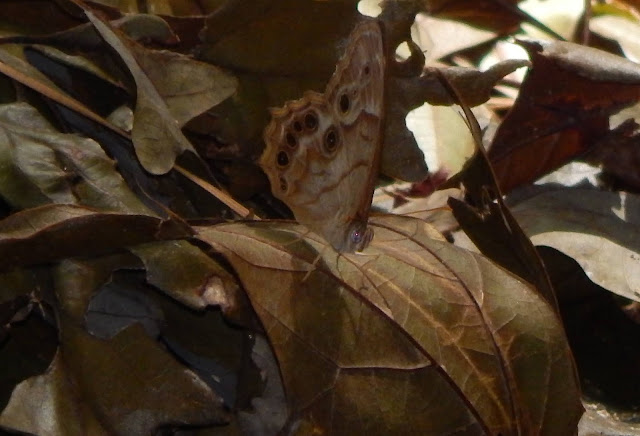 |
| Southern Pearly-eye - RF Trail |
.
 |
| Harvester, Rock Falls Trail - one of the more unusual butterflies encountered this month |
.
 |
| Rock Creek upstream from waterfall |
On the Sept. 12th trip I was joined by my father, who hadn't been to SI Hills in many years. We did the entire length of the main road and walked Rock Falls Trail down to the waterfall.
.
 |
| Cardinal Flower - creek just inside entrance to WMA |
.
 |
| side road in area that was partly logged a few years ago |
 |
| Eastern Wood-Pewee |
.
 |
| Eastern Wood-Pewee |
.
 |
| Eastern Tailed-Blue |
 |
| Carolina Satyr - |
.
 |
| Southern Broken-Dash on mountainmint |
.
 |
| Northern Broken-Dash nectaring on mountainmint |
.
.
(video: Rock Falls)
.
.
.
.
.
.
.
.
.
.
.
some species lists from these three visits to SI Hills:
Birds
Cloudless Sulphur -
Wildflowers seen on these trips included: mountainmint sp. (possibly Whiteleaf Mountainmint - ), Monarda sp. (possibly Spotted Beebalm - Monarda ), Cardinal Flower, Blue Mistflower, Elephant's Foot, "black-eyed Susan" sp. (Rudbeckia), Fabaceae spp., Bigroot Morning-Glory, Verbena spp., and doubtless many others that I'm forgetting (I didn't record plants in my notes and wasn't able to photo-document all species seen in flower).
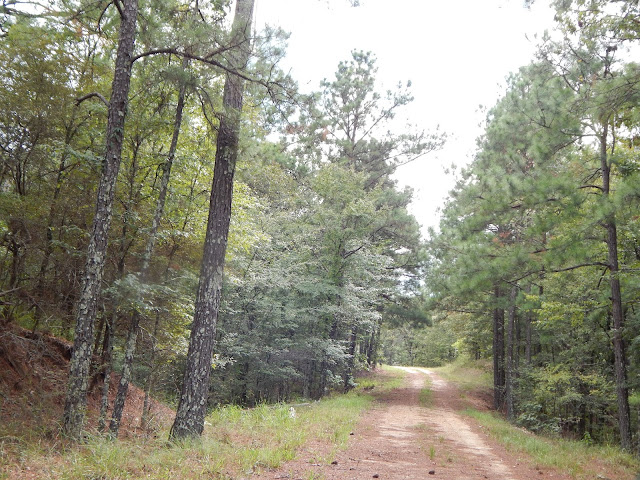 |
| main road NW section, along the stretch that has a more "piney-woods" flavor |
On Sept. 27th I finally walked to Big Creek, which I had been planning to do for some months. In the past couple of years, in late summer, I'd do this by driving to the end of the drive-able section of the side road that's east of Rock Falls, then walking the 'no vehicles' portion of that road to it's end, then walking through the woods north to the creek. However, as of this May, that road has been gated and is an ATV-only road. So, this time I started at the Rock Falls Nature Trail.
 |
| ... |
.
 |
| Rock Falls Trail |
 |
| Rock Falls |
 |
| ... |
.
 |
| Rock Falls |
From the waterfall, I walked along the ridgeside on the east side of Rock Creek for some distance downstream, before, corralled by the terrain, coming down to the creek and following it more closely.
 |
| ... |
.
 |
| Gemmed Satyr - I encountered several of these butterflies, and several Southern Pearly-eyes, while on this walk. |
 |
| Southern Pearly-eye (with damaged wing) - Cane (Arundinaria) is this butterfly's host plant, and both are common on the ridges and along the creek. |
.
 |
| ... |
 |
| Rock Creek |
.
 |
| Southern Pearly-eye at Rock Creek |
I avoided actually wading the creek or walking on the streambed whenever possible, though I did have to cross the creek a few times and use the streambed as a path in places as I picked a path downstream.
.
 |
| Rock Creek |
.
 |
| a small waterfall along the middle section of Rock Creek |
.
.
 |
| Creek Chubs appear to be the most numerous fish in Rock Creek. |
.
 |
| shiner/minnow (Cyprinid) sp. - There were some small shiners, such as this one, in Rock Creek, though I didn't know what species they were. |
 |
| crawfish sp. (gonna have to ask Dr. Jay for help with ID) - Crawfish that appear to be the same species as the one shown are common in the small spring water streams of Sicily Island Hills. |
.
 |
| ... |
.
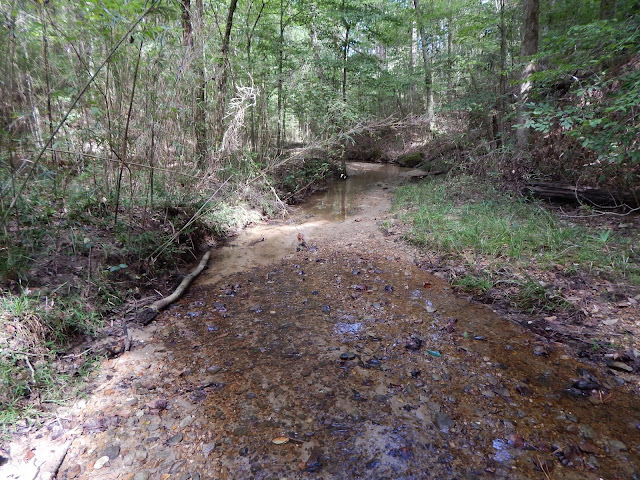 |
| Rock Creek |
.
On the walk down Rock Creek I found Least Skipper, Lace-winged Roadside-Skipper, and Clouded Skipper nectaring on Elephant's Foot and the few other flowers growing on the streambank in the deep woods.
.
 |
| lower Rock Creek |
.
Rock Creek empties into Big Creek at the downstream end of the stretch I'd traditionally visited the past couple of years.
.
 |
| mouth of Rock Creek at Big Creek |
.
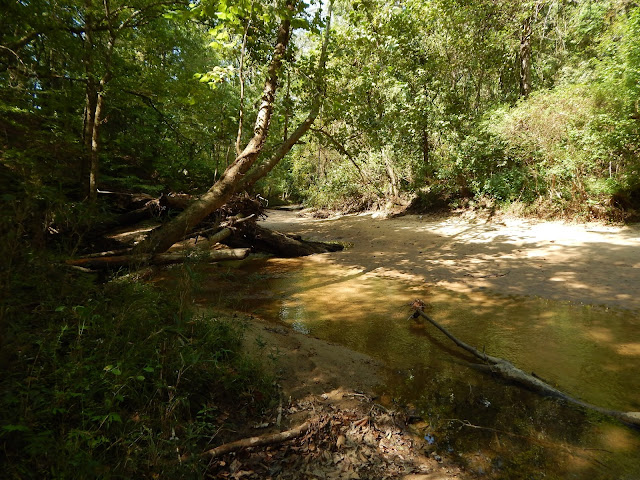 |
| Big Creek |
.
 |
| Big Creek and the mouth of Rock Creek |
I followed Big Creek upstream, walking on the wide sandy and gravely streambed and only wading across the water when necessary, until I reached the point where I'd normally come down the the creek when approaching from the now gated road.
.
 |
| Big Creek |
.
.
 |
| ... |
 |
| ... |
.
 |
| Summer Tanager eating elderberries - Big Creek is always a draw for diverse wildlife. Below are a few things seen there this time. |
 |
| Dun Skipper |
 |
| 'Astyanax' Red-spotted Purple - forest butterflies come down to the creek for the minerals and sun |
.
 |
| Lace-winged Roadside-Skipper sunning on creek bank |
.
 |
| Nine-banded Armadillo |
.
 |
| Nine-banded Armadillo |
I cut through the woods from here to the end of the afforementioned walking-only/ATV-only road, following it about halfway back to the main road, before cutting through the woods again to come out on Rock Falls Trail.
.
.
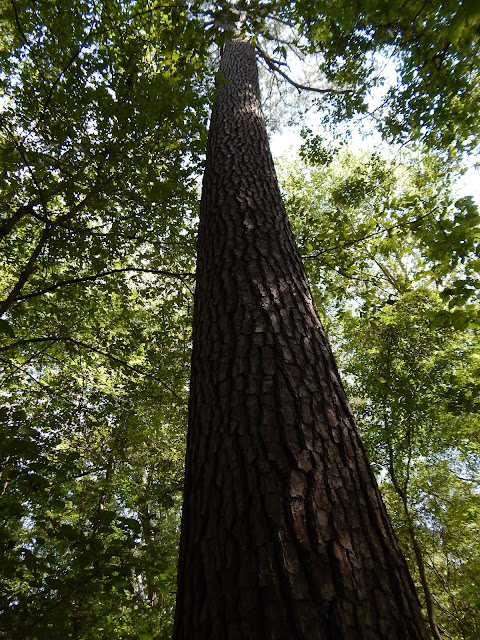 |
| ... |
 |
| ... |
 |
| ... |
.
 |
| ... |
.
 |
| heading uphill... |
.
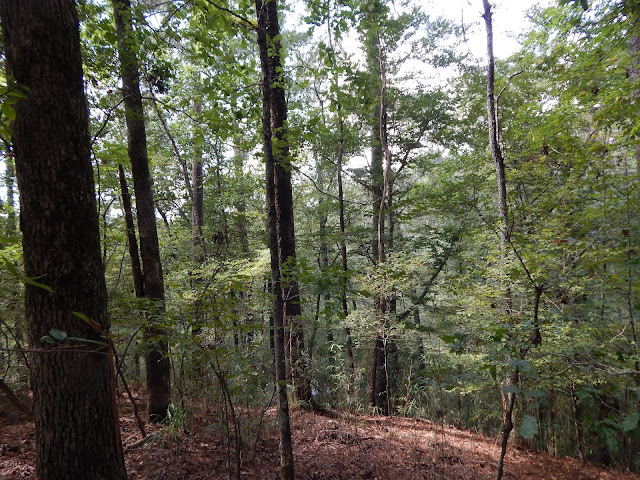 |
| looking back out over the creek bottoms from the top of the hill (swampy pond partially visible below) |
 |
| clearing at end of 'no vehicles' road at top of hill |
.
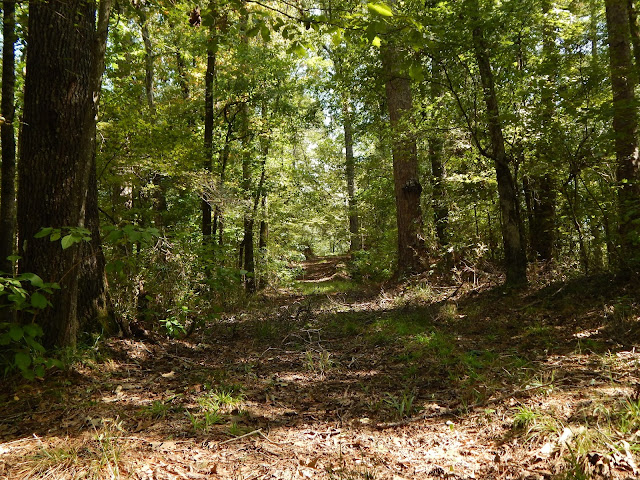 |
| 'no vehicles' road |
.
 |
| Gemmed Satyr |
.
 |
| Gemmed Satyr |
.
 |
| Southern Pearly-eye |
.
.
 |
| Worm-eating Warbler (a very common breeder here, but harder to find after mid-summer) - walking the road up from Big Creek, 9/27 |
 |
| ... |
.
 |
| ATV road |
.
 |
| through the woods... |
.
 |
| ... |
.
 |
| ...heading towards Rock Falls Trail upstream of waterfall |
.
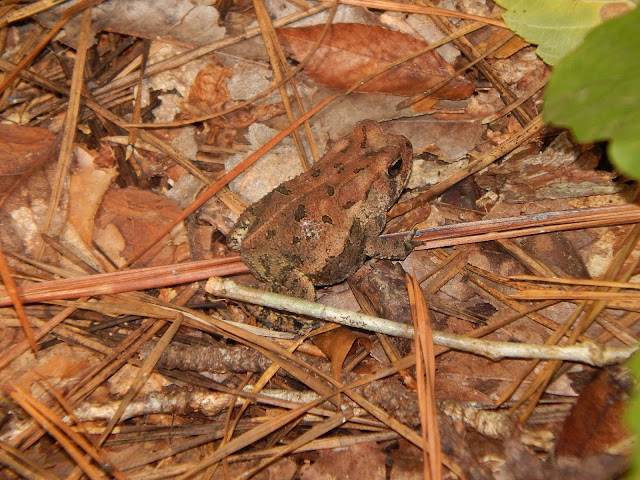 |
| Fowler's Toad near Rock Creek |
some species lists from these three visits to SI Hills:
September 2
9:58 a.m.; 3 hrs, 54 mins; 3.2 miles; 1 observer
warm; variable sky; breeze
September 12
1:26 p.m.; 3 hrs; 4.4 miles; 2 observers
warm; sunny for a while, then cloudy; not much wind, then gusts associated with nearby rain, then light breeze
September 27
8:39 a.m.; 7 hrs, 10 mins; 4.9 miles; 1 observer; most of time and majority of distance were on foot
70s-80s F.; foggy first few minutes, then sunny the rest of the time; light breeze
Birds
September is a slow time for woodland birding--the constant singing and bustling activity of breeding season is over, some summer species have departed, winter species haven't arrived yet, and it can be difficult to locate any passing migrants that have stopped to feed or rest among the countless trees of the woods. That said, there is stuff to see. The year-round residents like Tufted Titmice, Carolina Chickadees, and several woodpecker species are busy foraging in family groups--the nucleus of mixed-species flocks that roam the winter woods starting to take shape. Some summer residents, and their southbound brethren who spent the breeding season farther north, can be found quietly finding food or occasionally singing.
Mourning Dove - 2, 2, 1
Yellow-billed Cuckoo - 1, 0, 0
Chimney Swift - 0, 0, 1
Black Vulture - 0, 0, 1
Turkey Vulture -0, 1, 0
Red-shouldered Hawk - 0, 0, 1
Red-bellied Woodpecker - 3, 1, 21
Downy Woodpecker - 3, 2, 12
Pileated Woodpecker - 1, 1, 8
Eastern Wood-Pewee - 1, 2, 4
Acadian Flycatcher - 2, 2, 3
Empidonax sp. - 0, 3, 0
Great Crested Flycatcher - 0, 1, 0
White-eyed Vireo - 10, 7, 4
Red-eyed Vireo - 4, 0, 0
Blue Jay - 4, 3, 13
American Crow - 1, 0, 4
Carolina Chickadee - 6, 12, 25
Tufted Titmouse - 7, 2, 20
Northern Rough-winged Swallow - 0, 0, 1
Barn Swallow - 0, 0, 3
Blue-gray Gnatcatcher - 3, 1, 6
Carolina Wren - 14, 6, 31
Gray Catbird - 0, 0, 1
Brown Thrasher - 0, 0, 1
Swainson's Thrush - 0, 0, 1
Wood Thrush - 0, 0, 4
Worm-eating Warbler - 0, 0, 1
Hooded Warbler - 1, 0, 8
Pine Warbler - 5, 2, 10
Summer Tanager - 3, 1, 9
Northern Cardinal - 8, 5, 11
Indigo Bunting - 0, 0, 2
Butterflies
Butterfly activity was fairly good on these visits. Mountainmint flowers attracted a number of species of skippers as well as Eastern Tiger Swallowtails and both Red-banded and Gray Hairstreaks. Each day I found multiple Southern Pearly-eyes, one of the more interesting butterflies in these hills. One was hanging around fallen Osage Oranges along the primitive campground road. Most were seen in the woods around Rock Creek; they're often seen on the wet rocks of Rock Falls. On Sept. 2nd, while trying to photograph a So. P-eye along Rock Falls Trail, I spotted a Harvester.
Tropical Checkered-Skipper -
Clouded Skipper -
 |
| Clouded Skipper - 9/27 |
Least Skipper -
 |
| Least Skipper - lower stretch of Rock Creek 9/27 |
Southern Broken-Dash -
Northern Broken-Dash -
Dun Skipper -
 |
| Dun Skipper nectaring on mountainmint - 9/2 |
Lace-winged Roadside-Skipper -
 |
| Lace-winged Roadside-Skipper - middle stretch of Rock Creek, 9/27 |
Eastern Tiger Swallowtail -
Giant Swallowtail -
 |
| Cloudless Sulphur - main road, 9/12 |
Little Yellow -
 |
| Little Yellow - 9/2 |
Harvester -
 |
| Harvester - Rock Falls Trail, 9/2 |
 |
| Harvester - 9/2 |
Gray Hairstreak -
 |
| Gray Hairstreak - 9/2 |
Red-banded Hairstreak -
 |
| Red-banded Hairstreak - 9/2 |
Eastern Tailed-Blue -
 |
| Eastern Tailed-Blue - Sept. 2 |
 |
| Eastern Tailed-Blue 9/12 |
Gulf Fritillary -
 |
| Gulf Fritillary - 9/2 |
'Astyanax' Red-spotted Purple -
Pearl Crescent -
Goatweed Leafwing -
Southern Pearly-eye -
 |
| Southern Pearly-eye - middle stretch of Rock Creek, 9/27 |
pearly-eye sp. (probably additional Southerns) -
Gemmed Satyr - 1
Carolina Satyr -
 |
| Carolina Satyr - 9/12 |
Though birds and butterflies often take the spotlight, I'm interested in any and all wildlife. Mammals found on these visits include Gray and Fox Squirrels, Virginia Opossum, Nine-banded Armadillo, and the tracks of White-tailed Deer, Coyote, Bobcat, and Northern Raccoon (and of course, and unfortunately, feral hogs).
Herps (Amphibians and Reptiles) included Fowler's Toad, Blanchard's Cricket Frog, Cope's Gray Treefrog, Green (Bronze) Frog; Green Anole, Little Brown Skink, and Western Garter Snake. I may be forgetting some, so I'll add any omissions that I may find after reviewing field notes.
.
 |
| Osage Oranges - 9/ |
.
 |
| Osage Orange - 9/ |
Wildflowers seen on these trips included: mountainmint sp. (possibly Whiteleaf Mountainmint - ), Monarda sp. (possibly Spotted Beebalm - Monarda ), Cardinal Flower, Blue Mistflower, Elephant's Foot, "black-eyed Susan" sp. (Rudbeckia), Fabaceae spp., Bigroot Morning-Glory, Verbena spp., and doubtless many others that I'm forgetting (I didn't record plants in my notes and wasn't able to photo-document all species seen in flower).
.
 |
| ... |
As always, if you spot an incorrect ID please feel free to let me know in the comments.
**The post covering S.I. Hills October-December, 2020 will be up shortly.**
.













No comments:
Post a Comment